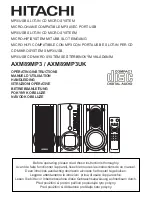
GloSSARY
AFL (After Fade Listen) a function that allows the operator to monitor the post-fade signal in a channel independently of the
main mix.
Balance
the relative levels of the left and right channels of a stereo signal.
Balanced
a method of audio connection which ‘balances’ the signal between two wires and a screen which carries
no signal. Any interference is picked up equally by the two wires, but out of phase resulting in
cancellation of the interference signal.
Clipping
the onset of severe distortion in the signal path, usually caused by the peak signal voltage being limited
by the circuit’s power supply voltage.
dB (decibel)
a ratio of two voltages or signal levels, expressed by the equation dB=20Log
10
(V1/V2). Adding the
suffix ’u’ denotes the ratio is relative to 0.775V RMS and‘V’ expresses the ratio relative to 1V RMS.
DI
(direct injection) the practice of connecting an electric musical instrument directly to the input of the
mixing console, rather than to an amplifier and loudspeaker which is covered by a microphone feeding
the console.
Effects
the use of devices to alter or process the sound to add special effects e.g. reverb, normally as a mix of
the original (‘dry’) sound and the treated version.
Equaliser
a device that allows the boosting or cutting of selected bands of frequencies in the signal path.
Feedback
the ‘howling’ sound caused by bringing a microphone too close to a loudspeaker driven from
its amplified signal.
Foldback
a feed sent back to the artistes via loudspeakers or headphones to enable them to monitor the
sounds they are producing.
FOLIO 4
the next best low cost quality mixer since FOLIO.
Frequency response the variation in gain of a device with frequency.
Ground compensation a technique used on unbalanced outputs to cancel out the effect of ground loops caused by
connections
to external equipment.
Headroom
the available signal range above the nominal level before clipping occurs.
High Pass Filter
a filter that rejects low frequencies.
Line level signals
at a nominal level of -10 to +6dBu, usually coming from a low impedance source.
Oscillator
a built-in tone generator for test and line-up purposes.
Peaking
an equaliser response curve affecting only a band of frequencies i.e. based on a bandpass response.
PFL (pre-fade listen) a function that allows the operator to monitor the pre-fade signal in a channel independently of the
main mix.
Phantom Power
the +48V d.c. voltage applied equally to the two signal pins of a balanced mic input to provide
powering for condenser microphones.
Post-Fade
the point in the signal path
after
the channel or master fader and therefore affected by fader positio
Processor
a device which affects the whole of the signal passing through it, e.g. gate, compressor or equaliser
Rolloff
a fall in gain at the extremes of the frequency response.
Shelving
an equaliser response affecting all frequencies above or below the break frequency
i.e. a highpass or lowpass derived response.
Signal to Noise Ratio
a expression of the difference in level between the audio signal and background system noise.
Spill
acoustic interference from other sources.
Sweep EQ
an Equaliser section ( e.g. MID EQ) which operates at a variable rather than fixed frequency giving
increased flexibility to the user.
Talkback
the operator speaking to the artistes or to tape via the auxiliary or group outputs.
Tape Return
a line level input provided specifically to receive the playback output of a tape machine
Tape Send
an independent pre-fade output of the Mix L & R signals to feed a 2-track tape or cassette machine
Transient
a momentary rise in the signal level.
TRS Jacks
a 3-pole jack with Tip, Ring and Sleeve connections
Unbalanced
a method of audio connection which uses a single signal wire and the cable screen as the signal return.
This method does not provide the noise immunity of a
balanced input
(see above).
24
SPIRIT FOLIO 4




































